NIPT is used to screen for chromosomal abnormalities as follows.
Main examples
Sex chromosomal aneuploidy:
Down syndrome (trisomy 21): a condition where there are usually three copies of chromosome 21
Edwards syndrome (trisomy 18): a condition where there are usually three copies of chromosome 18
Patau syndrome (trisomy 13): a condition where there are usually three copies of chromosome 13
Among the congenital diseases caused by changes in the 46 chromosomes humans have, the most frequent are trisomy 21, trisomy 18, and trisomy 13, which are also the most tested in our clinic. In addition, there are also tests that can only be performed at Hiro Clinic, so let’s look at some examples of these diseases together.
Disease frequency revealed by NIPT
The frequency of diseases detectable by NIPT mainly involves screening for the risk of Down syndrome and other chromosomal abnormalities. However, it cannot detect all abnormalities and is not a definitive diagnosis.
Nonetheless, NIPT is particularly accurate in detecting chromosomal numerical changes such as Down syndrome compared to traditional tests.
Prenatal diagnosis is now attracting a lot of attention in Japan, where the number of older births is increasing. However, you may be wondering what kind of test it is and when it can be done. Today we bring you the knowledge to help you answer that question.
The basics of NIPT and complex genes
This is where things get a little more difficult,
Humans have 46 chromosomes, which are usually aligned with autosomes (22 x 2) and sex chromosomes (XY, XX). However, changes in the number and shape of chromosomes can occur. For example, there are cases where there should be two chromosomes 21, but there are three. This is called trisomy 21(Down syndrome).
Also, if an excess or deficiency in the amount of chromosomes occurs. An excess or deficiency of genes can occur, leading to birth defects and constitutional causes (chromosomal disorders). This can significantly affect the baby’s development.
You may not have heard much about the disease, except for Down syndrome. Although not often mentioned in the media, it is also true that there are more sex chromosome abnormalities and diseases in which some genes are missing or increased(whole autosomal whole-region partial deletion/duplication disease)than you might think. Typical diseases and their frequency are listed below.
- Determination of sex chromosome aneuploidy
- Gender determination
- Whole autosomal whole-region partial deletion/duplication disease
| Rank | Diseases Detectable | Characteristics | Max Frequency | Min Frequency | At Our Clinic | Applicable Plans | |
|---|---|---|---|---|---|---|---|
| 1 | Klinefelter Syndrome | XXY | Sex Chromosome | 1/500 | 1/1000 | Basic Plan A, B, G, F Premium Plan Hms, AM,BM,GM,FM, GM+, FM+ |
|
| 2 | Triple X Syndrome | XXX | Sex Chromosome | 1/800 | 1/1000 | Basic Plan A,B,G, F Premium Plan AM,BM,GM,FM,GM+, FM+ |
|
| 3 | Down Syndrome | 21 | Trisomy | 1/1000 | 1/1000 | 1/135 | All Plans Basic Plan Premium Plan |
| 4 | Turner Syndrome | XO | Sex Chromosome | 1/1000 | 1/2500 | Basic Plan A,B, G, F Premium Plan Hms,AM,BM, GM, FM, GM+, FM+ |
|
| 5 | DiGeorge Syndrome | 22 | Microdeletion | 1/2000 | 1/6000 | Premium Plan Hm, Hms, Om, AM,BM, GM, FM, GM+, FM+ |
|
| 6 | Edwards Syndrome | 18 | Trisomy | 1/3500 | 1/8500 | 1/214 | Basic Plan O, A, B, G, F Premium Plan Om,AM, BM, GM,FM, GM+, FM+ |
| 7 | 1p36 Deletion Syndrome | 1 | Microdeletion | 1/5000 | 1/10000 | Basic Plan AM,BM,GM,FM,GM+, FM+ |
|
| 8 | Patau Syndrome | 13 | Trisomy | 1/5000 | 1/12000 | 1/679 | Basic Plan O,A,B,G,F, Premium Plan AM,Om, BM,GM,FM, GM+,FM+ |
| 9 | Smith-Magenis Syndrome | 17 | Microdeletion | 1/15000 | 1/25000 | Premium Plan AM,BM,GM,FM,GM+, FM+ |
|
| 10 | Wolf-Hirschhorn Syndrome | 4 | Microdeletion | 1/50000 | 1/96000 | Premium Plan AM,BM,GM,FM,GM+, FM+ |
This is a breakdown of the 32923 examinees who were examined at the clinic. (as of 2023/4)
| No.21 | No.18 | No.13 | Sex chromosome | Except No. 21,18,13 Sex chromosome | Partial deletion Partial duplication |
|
|---|---|---|---|---|---|---|
| No. of disease sites | 237 people | 149 people | 47 people | 134 people | 177 people | 125 people |
| 35 above | 187 people | 120 people | 29 people | 77 people | 111 people | 69 people |
| Under 35 | 50 people | 29 people | 18 people | 57 people | 66 people | 56 people |
| Multiplier between ages | 374% | 414% | 161% | 135% | 168% | 123% |
Our hospital maintains a database of all information, so we can accumulate more than 30,000 data to date and provide information as required.
Chromosome 21, 18 and 13 trisomy
Among congenital disorders caused by changes in the number of chromosomes, of which there are 46, the most frequent are chromosome 21 trisomy, chromosome 18 trisomy and chromosome 13 trisomy.
The three diseases are characterised by the following features.
Chromosome 21 trisomy (Down syndrome)
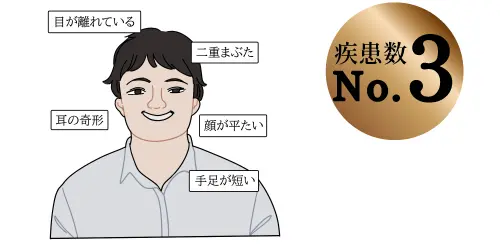
It is caused by a high copy number of chromosome 21 and is also known as Down syndrome.Down syndrome is the most common intellectual disability caused by genetic problems, their physical characteristics include ‘growth retardation’, ‘reduced muscle tone’ and ‘characteristic facial features’.
Complications include ‘thyroid disease’, ‘otolaryngological diseases’, ‘ophthalmological diseases’, etc. Some may also have organ damage, for example congenital heart disease, which may require medical treatment. The average IQ is said to be 50.
Many of these children attend local schools or special schools while using support classes. They may be active in a variety of fields, including sport and the arts.
Life expectancy is often 50-60 years.
bImage search for chromosome 21 trisomy by bing
Chromosome 18 trisomy (Edwards syndrome)
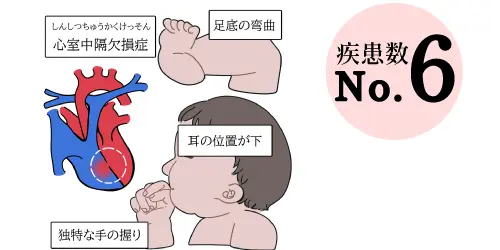
Caused by high copy number of chromosome 18, also known as Edwards syndrome. It is caused by stunting in the womb, often resulting in miscarriage or stillbirth.Their physical characteristics include “growth disturbances from the fetal stage” and “breathing and feeding disorders”.
Complications include “heart disease (90%)”, “gastrointestinal malformations”, “cleft lip and palate” and “joint contractures”, and even if born alive, most have multiple congenital defects in the brain, heart and other areas, and often die before the age of one. Those children who survive develop the problems of intellectual and developmental disabilities.
Image search for chromosome 18 trisomy by bing
Chromosome 13 trisomy (Patau syndrome)
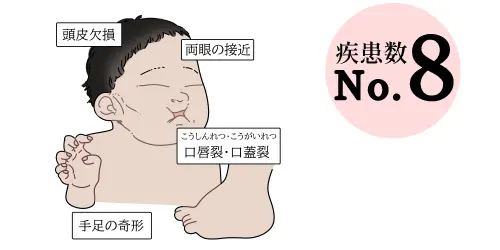
Caused by the number of chromosomes in the 13th chromosome being reduced to three, it is also known as Patau syndrome. Most children will have congenital defects in the brain and other organs.
Their physical characteristics include ‘growth disorders’ and ‘breathing and eating disorders’.
Complications include ‘cleft lip and palate’, ‘polydactyly’, ‘eye disease’, ‘heart disease (80%)’ and ‘total anterior cisternia’, which are congenital defects in the brain and organs.
The disease often results in miscarriage or stillbirth, with 80% of live births occurring before the first month of life, and 10% of children dying within a year of birth. It is known that the disease is slightly less severe in cases of mosaicism, where all three chromosomes 13 are not present, but some are mixed.
Image search for chromosome 13 trisomy by bing
Abnormal number of sex chromosomes
Sex chromosome disorders are often described as abnormal in number. This is caused by chromosome disjunctions.
Here are some cases of sex chromosome aneuploidy.
Klinefelter syndrome
47,XXY、48,XXXY、46,XY / 47,XXY
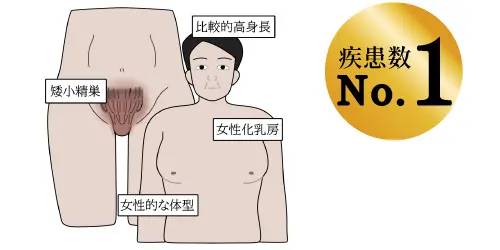
Birth frequency is 1 in 1000 live births of boys.
About half of all cases of Klinefelter’s syndrome are caused by chromosome disjunctions in the father. Maternal-derived disjunctions are influenced by the mother’s age at birth.
It is not noticed at an early age because of its outward appearance as a male. The symptoms include poor development of secondary sexual characteristics (poor development of body hair and muscle tissue), tendency toward feminization (breast development), large limbs and long lower legs (tall stature), and small testicles and azoospermia (infertility). There is little or no intellectual decline or survival impairment; however, the greater the number of X’s, the more cases with intellectual decline there are.
Image search for Kleinfelter’s syndrome by bing
The diseases that can be examined with the following plans are:
Basic Plan: A・B・G・F
Premium Plan: Hms・Oms・AM・BM・GM・ FM・GM+・FM+
Turner syndrome
45,X
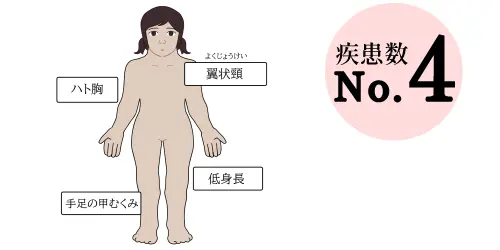
Birth frequency is 1 in 2500 live births of girls.
Turner syndrome is not age-dependent on the mother. About 80% of cases are found as monosomies (one X chromosome), where the X chromosome is known to be of maternal origin, meaning that the paternal origin is often lost. 10% of X monosomies are spontaneous abortions, and 15% of all pregnancies result in a miscarriage. It is not yet known what causes the difference between spontaneous abortions and those that result in birth.
Outwardly, she is female. Symptoms include lymphoedema, external elbows and pterygoid neck, short stature, delayed sexual maturity and amenorrhoea.
Image search for Turner syndrome by bing
XXX syndrome
47,XXX
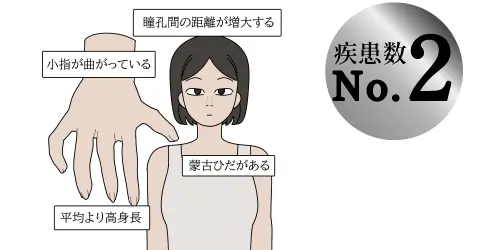
Birth frequency is 1 in 1000 live births of girls.
XXX syndrome, like normal women, has one X activity, so even if a woman has three Xs, there are no physical findings because two are inactive (not competent for inheritance). They are also fertile.
Image search for XXX syndrome by bing
XYY syndrome
47,XYY、48,XXYY
The frequency of births is 1 per 1000 live births of boys.
XYY syndrome has no physical findings apart from height.
Image search for XYY syndrome by bing
Gender determination
The gender of the foetus is determined by the chromosomes carried by the father’s sperm.
Therefore, the gender is already determined when the egg is fertilised: if the mother’s egg is fertilised by a sperm carrying a Y chromosome, it is a boy; if the egg is fertilised by a sperm carrying an X chromosome, it is a girl. The gender of the foetus can usually be determined after 18-20 weeks’ gestation with echo testing, whereas with NIPT, the gender of the foetus can be determined once the pregnancy is confirmed by echo testing.
The most appropriate way to find out the sex is to test in families with X-linked recessive genetic disorders. If an X-linked recessive gene is present in the foetus’s grandfather, his daughter is usually a carrier (carries the abnormal gene but has no symptoms). If the daughter is a boy, there is a 50% chance that she will develop the condition by gender determination at the time of conception. If it is a girl, 50% will be a carrier. Of course, the remaining 50% of boys and 50% of girls are genetically intact, so the gene will not be passed on to their descendants in the future.
Whole autosomal whole-region partial deletion/duplication disease
(Checking whether some autosomal regions are missing or increased)
Although the difficult term chromosome aberration disease is used, whole autosomal whole-region partial deletion diseases are too small to be detected by normal chromosome tests. Diagnosis therefore requires special tests to confirm the diagnosis. It is recognised by the Ministry of Health, Labour and Welfare as a designated intractable disease.
This test can only be performed in laboratories that have the VeriSeqNIPT Solution V2; as of 12 June 2021, the test is only available in Japan at the Hiro Clinic, which is affiliated with the Tokyo Health Laboratory, which has the VeriSeqNIPT Solution V2. We initially thought that this abnormality would be rare before testing, but after testing just under 10,000 pregnant women, we found an abnormality in about one in 285. It is known that the amount of genetic variation (increase or decrease) is related to the severity of the disease; a deletion or duplication of more than 7 million bases is likely to result in a birth with some form of the disease, although not as severe as a normal trisomy or monosomy. For example, a number 1 trisomy (no mosaicism) is almost impossible to survive, but a partial deletion or duplication of chromosome 1 may be sufficient for survival. Hiro Clinic NIPT considers the disease to be potentially survivable despite the disability.
The laboratory’s sequencer cannot detect deletions and duplications below 7 million bases, but it can check for partial deletions and duplications in all autosomal regions.
The diseases that can be examined with the following plans are:
Basic Plan: G・F
Premium Plan: GM・FM・GM+・FM+
Typical deletion syndromes are listed below. (Not all of these syndromes can be detected.)
4 types of Microdeletion syndromes
1p36 deletion syndrome
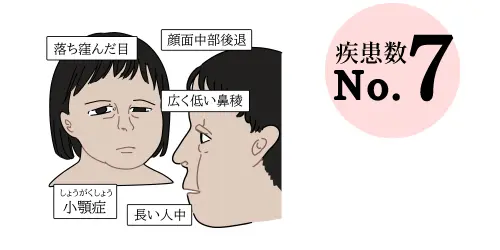
1p36 deletion syndrome is a birth defect caused by the absence of a very small site on the short arm of chromosome 1.
Characteristics such as characteristic facial features, delayed mental development and epileptic seizures (convulsions, disorientation) are manifested. They may also be born with heart problems.
Image search for 1p36 deletion syndrome trisomy by bing
4p deletion syndrome (Wolf-Hirschhorn syndrome)
4p deletion syndrome, also known as ‘Wolf-Hirschhorn syndrome’, is a birth defect caused by the absence of a site on the short arm of chromosome 4.
Severe mental developmental delay, growth retardation, intractable epilepsy and multiple morphological abnormalities.
Image search for 4p deletion syndrome by bing
The diseases that can be examined with the Premium Plan are:
Premium Plan: Hm・Hms・Om・Oms・AM・BM・GM・FM・GM+・FM+
Smith-Magenis syndrome
Smith-Magenis syndrome is one of a number of congenital anomaly syndromes affecting many parts of the body. Key features include mild to moderate intellectual disability, delayed language skills, characteristic facial features, sleep disturbances and behavioural problems. A small deletion of chromosome 17 in each cell results in Smith-Magenis syndrome. This deletion occurs at a position called p11.2 on the short (p) arm of the chromosome.
Image search for Smith-Magenis syndrome by bing
The diseases that can be examined with the Premium Plan are:
Premium Plan: Hm・Hms・Om・Oms・AM・BM・GM・FM・GM+・FM+
22q11.2 Deletion syndrome (DiGeorge syndrome)
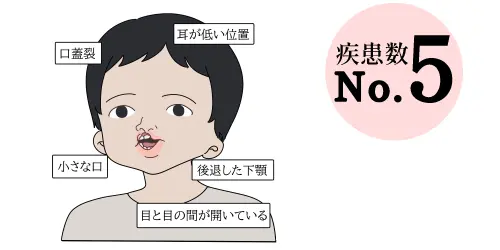
It is known as ‘Di George syndrome’ and is a birth defect caused by the absence of about 30 genes located in a very small site on chromosome 22.
Congenital heart disease, delayed mental development, characteristic facial features, immunocompromised, cleft palate and soft palate closure, nasal voice, hypocalcaemia.
Image search for DiGeorge syndrome by bing
Total chromosome aneuploidy test
(Check for anomalies in numbers)
Hiro Clinic NIPT offers ‘all chromosomes’ (chromosomes 1 to 22, X and Y) testing, including chromosomes other than 21 trisomy, 18 trisomy and 13 trisomy. Mosaicism, in which all chromosomes in all cells are trisomic, is often associated with poor survival, but mosaic cases have been reported in which all chromosomes from chromosomes 1 to 22 have survived. The proportion of such cases is increasing due to the ageing of pregnant women. Hiro Clinic NIPT offers the Basic Plan B, which includes this test. It detects not only trisomy but also monosomy.
It is particularly recommended for pregnant women over 35 years of age. The test is commonly performed in countries with advanced thinking, such as Belgium.
Q&A
-
QWhat is trisomy, which can be detected by prenatal diagnosis?Trisomy is a condition in which three chromosomes are present instead of the usual two. Typical examples are trisomy 21 (Down syndrome) and trisomy 18 (Edwards syndrome).
-
QCan NIPT also determine gender?Yes, since NIPT analyzes sex chromosomes, it is possible to determine the sex of the fetus. However, ethical considerations may be required for testing for the purpose of gender determination.
-
QWhat are some of the sex chromosome abnormalities that can be detected by NIPT?Klinefelter syndrome (XXY), Turner syndrome (XO), XXX syndrome, XYY syndrome, etc. can be determined.
-
QCan microdeletion syndromes be detected by prenatal diagnosis?Yes, microdeletion syndromes such as 22q11.2 deletion syndrome (Di George syndrome) and 1p36 deletion syndrome can be determined.
-
QIn what cases can “partial deletions” or “partial duplications” be detected by NIPT?Whole autosomal partial deletions or duplications can be detected. These are abnormalities that are difficult to detect with conventional chromosome testing.
-
QWhat kinds of aneuploidies can be detected by NIPT?Aneuploidy (monosomy and trisomy) of all chromosomes, including trisomy of chromosomes 21, 18, and 13, is covered.
-
QWhat is the frequency of chromosomal abnormalities that can be determined by NIPT?The frequency of Down syndrome is about 1/1000, Edwards syndrome about 1/3500, and Patow syndrome about 1/5000.
-
QWhat happens if a chromosomal abnormality is found during prenatal diagnosis?If the NIPT result is positive, it is recommended that a definitive diagnosis, such as an amniotic fluid test, be obtained. We will then consult with your doctor and proceed with the appropriate choice.
-
QCan NIPT detect all fetal abnormalities?No. NIPT is a screening test for specific chromosomal abnormalities and does not detect all congenital diseases or abnormalities.
-
QWhen is the appropriate time to undergo prenatal diagnosis?NIPT is often available from 10 weeks of pregnancy, but an early appointment is recommended to take into account the schedule for a definitive diagnosis.
-
QHow can prenatal diagnosis identify the risk of Edwards syndrome?NIPT evaluates the risk of Edwards syndrome by analyzing the amount of DNA on chromosome 18 to determine the likelihood of trisomy.
-
QWhat is the difference between sex chromosome aberration testing and sex determination with NIPT?Sex chromosome aberration testing confirms abnormalities in the number and structure of chromosomes. On the other hand, sex determination determines the sex of the fetus as determined by the sex chromosomes (XX or XY).
-
QWhat are some examples of cases in which prenatal diagnosis can identify genetic disease risk?This includes X-linked recessive genetic disorders. This allows for assessment of genetic disease risk within a family.
-
QHow does NIPT examine fetal DNA information?NIPT analyzes DNA fragments of fetal origin in the mother's blood for chromosomal abnormalities.
-
QWhat is the probability of finding a partial deletion with NIPT?The detection rate of partial deletions and duplications is approximately 1/285% of all pregnant women.
-
QHow will a positive prenatal diagnosis result affect my life after birth?Depending on the disease of the positive result, medical care and social services support may be required.
-
QDo I need genetic counseling based on NIPT results?Genetic counseling is important in the case of a positive or unclear result. You can discuss your future options with a specialist.
-
QWhat are some examples of “microdeletion syndromes” that can be identified by NIPT?Examples include Di George syndrome, 1p36 deletion syndrome, and Wolff-Hirschhorn syndrome.
-
QWhat are the limitations of what prenatal diagnosis can tell us?NIPT assesses the risk of chromosomal abnormalities with a high degree of accuracy, but it does not detect all congenital diseases.
-
QWhy do NIPT results sometimes not match the actual fetal condition?Because NIPT examines DNA derived from the placenta, discrepancies may occur when the placenta and fetus have different genetic information.
 中文
中文









